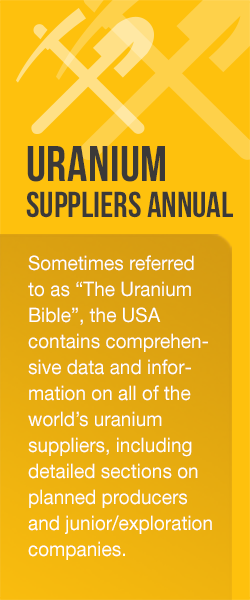The Long View: Forecasting Nuclear Power to 2040
The year 2040 may seem like a very long time from now, but in “nuclear years” it is actually much closer than one might think. As many can appreciate, things in the nuclear industry often take a long time to develop. From start to finish, a new nuclear power plant project can take at least a decade when factoring in planning, licensing, construction, and commissioning. Once up and running, a reactor typically operates for 40-60 years, which makes it one of the most durable, large-scale energy production facilities in the world. Consider that a new reactor being built today will likely still be operating in the 2070s! Thus, all things being equal, the decisions being made today surrounding nuclear power will have very long-lasting implications.
It is with this frame of reference that UxC recently extended its timeframe in forecasting the future of nuclear power. UxC started publishing its own nuclear power forecasts in 2007 through its Nuclear Power Outlook (NPO) service. Since then, we have progressively been making improvements to these forecasts. The fact that we update our forecasts every three months provides us an opportunity to make timely changes based on the constant shifts in the industry. We have also made major upgrades along the way. In Q1 2009, we expanded our forecasts to include three scenarios – High, Base, and Low. Then, in Q1 2010, we released the UxC Requirements Model (URM), which is a sleek, multi-functional, and highly adaptable tool to forecast nuclear fuel cycle requirements. As part of our most recent, Q1 2013 NPO update, we addressed a new challenge: extending our forecasts to 2040 from the previous end-point of 2030. The main impetus for this extension is our belief that 2030 is no longer an adequate timeframe to depict the future trajectories of the industry.
At the outset, we should note that other organizations have issued nuclear power forecasts for a number of years. These include the World Nuclear Association, International Atomic Energy Agency, OECD’s International Energy Agency/Nuclear Energy Agency, and the U.S. Energy Information Administration. As a relative newcomer, our purpose is to produce independent forecasts that offer a detailed, comprehensive perspective of the possible future for nuclear power specifically focused on analyzing the future market potential of this industry. The extension of our forecasts to 2040 thus represents a natural progression of these efforts.
One of the critical aspects for our 2040 forecast extension is the future operation of the current fleet of reactors. Notably, of the current 432 operating reactors, 326 units with about 278 gigawatts-electric (GWe) in capacity began commercial operations before 1990. Of these, 114 units (79 GWe) began operating before 1980. It is therefore quite important to consider the fate of these existing units when examining the future of nuclear power after 2030, as many of these older units will likely start to phase out, especially after 2030. While 60-year lifespans are the norm in the U.S. and several other countries, and there is even work being done on “Life after 60” programs that could extend the current fleet to up to 80 years, we must all accept the reality that these reactors will likely start to hit their limits in terms of safe and economical operations. In certain countries, such as Russia and South Korea, efforts are already underway to replace aging plants. However, there is no such planning to replace the current mainstays of the nuclear fleets in North America and Western Europe. By extending our forecasts past 2030, we can now see the implications of these and related decisions being made today in countries with large nuclear power programs.
Another hugely important aspect of UxC’s 2040 reactor forecast is the ability to address the magnitude of new build programs and the related shifting geographic center of nuclear power away from the traditional leaders in North America and Western Europe towards Asia and other parts of the world. Given that approximately 62% of the world’s installed nuclear power capacity currently resides in North America and Western Europe (see graph below), there are obvious questions about the implications of nuclear power growth in other parts of the world. By extending our NPO forecasts to 2040, we can now see that, in our Base case scenario, there will likely be a dramatic shift in the regional shares. UxC’s forecast suggests that Asia and Oceania will expand at a rapid pace and represent about 51% of the future installed nuclear capacity in 2040. Meanwhile, the roles of North America and Western Europe will be reduced by a combined 28%. There is also likely to be dramatic growth in Africa and the Middle East as well as South America, which will combine for about 9% compared with the current level of just over 1%. The implications of these future shifts in regional balances are tremendous not only in terms of the varying role that nuclear power will play in the energy mix in these different regions but also in terms of the market opportunities for suppliers of nuclear fuel and other inputs to the global nuclear reactor industry.
One more important aspect to UxC’s new 2040 forecasts is in providing a frame of reference regarding the High and Low case futures for nuclear power. UxC’s High case takes an optimistic, “blue sky” approach to the future of nuclear power. Although it is still grounded in reality and should be viewed as possible, there are many external factors that will need to come together to ensure this positive future. Beyond just higher economic growth that requires more energy of all kinds, there are specific factors that will necessarily influence a High case. Among these, we consider the following factors as most critical in determining a large expansion of nuclear power around the world:
• Rising costs of competing energy fuels, including natural gas, coal, and renewables that make the economics of nuclear power more attractive.
• Increased global attention to the issue of global warming and climate change forces a higher cost on carbon emissions, thereby increasing the competitiveness and attractiveness of nuclear power.
• Current and near-term new reactor construction projects proceed on relatively positive budgets and schedules, providing confidence for future new builds.
• Regulatory and policy trends are more favorable to nuclear power.
• No more Fukushima-type accidents occur.
In contrast, the Low case takes a much more subdued and negative view of the future of nuclear power. Although it is not an exact opposite of the High case, the primary assumptions are much less positive. The view behind the Low case is that nuclear power will continue to suffer from various internal and external negative factors that prevent either large-scale new build programs or long-term extensions of existing fleets.
Ultimately, although we believe that our Base case provides the most realistic and balanced depiction of the future outlook for nuclear power through 2040, our High and Low cases offer our NPO subscribers a maximum and minimum threshold to help frame the best and worst case future outcomes for nuclear power in the long-term.
Much is said about China’s influence on the nuclear industry. While it is nearly impossible to underestimate the oversized role that China will have on this industry going forward, there are also several other countries that are hugely important in determining the direction of nuclear power through 2040 as evidenced by our new forecasts. In addition to China, the political and economic decisions surrounding energy issues in the U.S., France, Japan, Russia, South Korea, and India will all be extremely influential in shaping the future of nuclear power. Moreover, by extending our outlook another ten years, we can now see which newcomer countries will have the most impact through 2040.
In conclusion, by extending our NPO forecasts to 2040, UxC has begun an important process of expanding the outlook to ascertain what the long-term future holds for this crucial energy source. This timeframe better captures the transitions that will take place in the industry, as older reactors give way to new ones, and the regional distribution of nuclear power capacity evolves.


